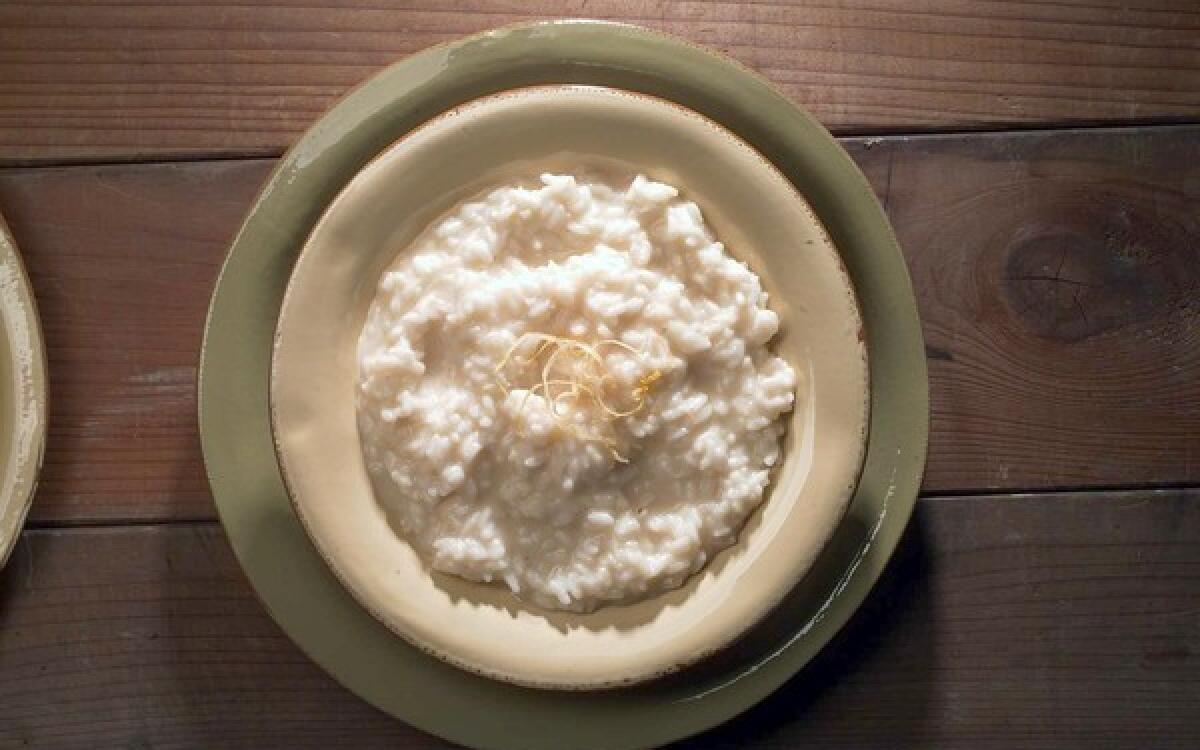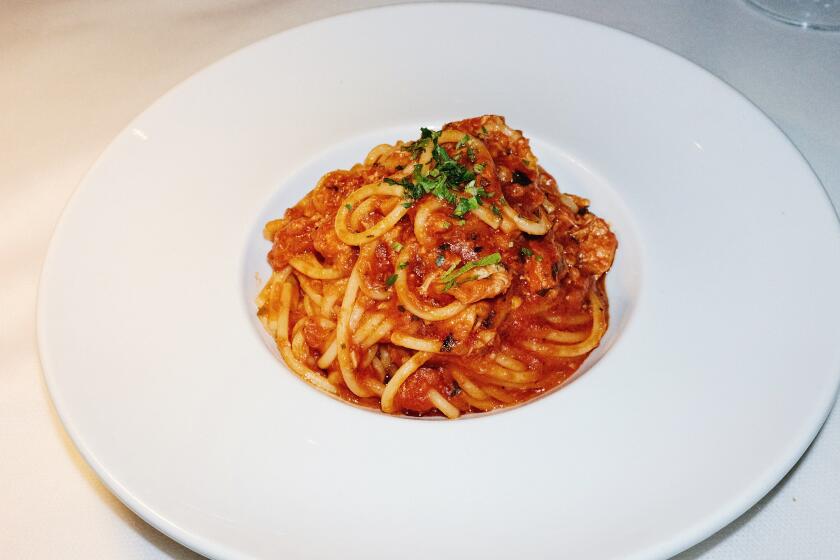Lemon risotto

- Share via
There are few more alluring -- and satisfying -- dishes than braises, especially now that there’s a little chill in the air. Inevitably, they’re fork-tender and flavorful, glossy with rich, aromatic sauces of stock and wine. That’s why it’s hard to resist the braised veal cheeks at Maple Drive, the pork shanks at Jar or the short ribs at Melisse. Or osso buco anywhere.
Chefs will have you believe that braising is a technique that requires years of practice, but the truth is, anyone who can brown a piece of meat and add some liquid can make a great braise.
We’re not talking Grandma’s pot roast. Once you understand a few simple principles it’s easy to create braises as elegant and flavorful as those you find in great restaurants.
As a technique, braising couldn’t be simpler. You just brown whatever it is you’re going to braise (in oil or butter), add liquids -- wine, stock or even cider or Armagnac -- cover, and cook slowly until it’s tender. Add aromatics to the liquid -- onion, carrots, herbs, spices -- and the flavors will suffuse whatever you’re braising. The simmering can happen on top of the stove or in the oven. The bonus? The marvelous aromas that fill the house as a veal shank or pork shoulder roast simmers slowly throughout a lazy afternoon.
The secret to achieving superlative braised meat dishes is twofold.
First, make sure to brown the meat really well. Use olive oil or butter, depending on the flavor you’re looking for -- or a combination, if you want the old-world richness of butter and the flavor of olive oil. Use a heavy pan, but preferably not a nonstick one so you can deglaze the pan and release all the caramelized flavor that was cooked into the braising liquid, which will become the sauce.
Second, use flavorful liquids to braise. Red or white wine and homemade stocks ensure delicious results. And don’t be afraid to raid the liquor cabinet: Vermouth, Armagnac, Cognac, Calvados -- all these can add elegance and depth of flavor to a braise.
The word “braise” comes from the French word for glowing embers. Once upon a time, braziers -- heavy, round pots with heavy lids -- were used to cook meat and vegetables slowly while suspended over coals with a small amount of liquid inside. The pots were tightly covered so the moisture -- and all the flavor -- stayed trapped inside. On top of the lid was a depression on which more hot coals could be placed, allowing the braise to cook slowly from above and below. In those days, braziers were used in place of ovens, which most people didn’t own, but braising in an oven has much the same effect.
Braising is forgiving. You can easily overcook a lamb chop, but when you braise, you can’t really make any mistakes. You could braise a shoe in veal stock and red wine and that would probably taste good. Although the process takes a couple of hours, it’s not at all labor-intensive: Once the pot is simmering on top of the stove or in the oven, the braise cooks itself.
As the braising progresses, the flavors of the meat, seasonings and aromatic vegetables infuse the cooking liquid, which can then easily be turned into a sauce. Fennel seeds, garlic and sliced fresh fennel work gorgeously with pork; thyme or rosemary are naturals with lamb. Adding tomato to just about any meat takes a sauce into a different dimension. Bay leaves, mirepoix (diced onion, carrot and celery), dried fruit -- the possibilities are endless.
Making the sauce can be as simple as skimming the fat from the braising liquid, then reducing it a little (as with our cider-braised pork with fennel). Or, if it wants body, you might whisk in a little beurre manie, a bit of flour blended into softened butter with a fork. Flouring the meat before browning it achieves a similar effect, though sometimes it’s nice to brown meat without flouring it.
Braising is ideal for do-ahead cooking -- in fact, most braises are even better the next day. They’re the perfect thing to make on a weekend, when you can take your time and bask in the aromas. The next day (or a couple of days later) the flavors will have deepened, and you can breeze in after a long work day, lift off any solidified fat, reheat the dish and enjoy an amazing, warming dinner.
But last-minute types shouldn’t ignore the technique; it’s a great -- and quick -- way to add a measure of glamour to winter vegetables such as kale, cauliflower, celery hearts or bok choy. You can even quickly braise fish or shellfish.
Many different meats respond well to braising. You can use a large cut such as a bottom round roast for the classic boeuf a la mode (OK, it’s a forgotten classic). For this dish, the beef is larded, then marinated in wine, garlic, onions and herbs, then braised. Or you can braise small pieces, as in stew meat. Or try something in-between: lamb or veal shanks or cut-up chicken or duck.
Where larger cuts of meat are concerned, tough or fatty ones work best. The fat in the meat is a natural baster in the long, slow cooking process that tenderizes tough cuts and melds all the flavors. For stew, using meat with enough fat is essential for ensuring tenderness.
To braise meats, choose a covered, heavy pan that isn’t too much larger than whatever you’re braising; that way you won’t need too much liquid and the flavors will concentrate. Dutch ovens work well.
Braising is the ideal treatment for lamb shanks, which are wonderfully rich, meaty and inexpensive; they’re terrific braised in red wine. For our version, we chose Merlot, but Cabernet, Zinfandel or Syrah would work just as well. Chicken and beef broth are combined with the wine (though straight beef broth would be fine, too). Prunes macerated in Port deepen the flavor and, along with dried apricots, add a touch of faintly North African sweetness. The result is a meltingly tender, very rich dish with a beautiful, deep, dark sauce. Serve it with couscous or mashed turnips.
When preparing lamb shanks for braising, remove any tough silver skin from the outside of the shanks. Use the tip of a small knife to loosen and pull it off. Once the shanks are seasoned and coated with flour, brown them in oil. Try to get a good even browning over the shanks; the browning will give the sauce a rich color and seal the juices in the meat.
Pork pot roasts are wonderful braised, and hard cider is a natural medium. Pork butt (actually part of the shoulder) has enough fat and flavor to yield very rich, tender, delicious slices of meat when prepared this way. We garnish them with sliced braised fennel and a little fleur de sel mixed with fennel seed.
Our osso buco is a fairly classic version of everyone’s favorite veal shank dish. Pancetta and cipollini (an onion-like bulb) are sauteed, along with colorful mirepoix, and added to the shanks braising in veal stock. (You can make your own veal stock, pick up a good frozen one at a well-stocked supermarket or even substitute a good chicken stock.) We’ve foregone the traditional garnish of gremolata -- chopped parsley, garlic and lemon zest -- in favor of serving it with parsley-flecked lemon risotto.
When preparing osso buco for braising, be sure to tie a string tightly around each veal shank to hold the meat on the bone as it cooks. When turning the veal, do so gently, so the precious marrow doesn’t fall out of the bone. You want it intact, so you can scoop it out with a spoon and savor every last bit.
If you want to break out of the rut of spartan lightly steamed vegetables, try braising them. One of our favorite sides to accompany Asian-style fish or pork dishes is braised baby bok choy. It couldn’t be simpler. Slice the bok choy in half lengthwise. Heat a little peanut or canola oil in a saute pan. Place the bok choy flat side down and let it sear till it’s just a little brown. Sear on the other side, add a little chicken stock and tamari, cover and simmer until just tender. A drizzle of toasted sesame oil -- or toasted sesame seeds -- finishes it.
For a light starter, braise whole trimmed leeks in nothing more than salted water -- these don’t even need to be browned first -- then dress them in a simple vinaigrette, add a drizzle of crushed pink peppercorns, and serve them at room temperature.
Celery hearts completely change character when braised. Quarter and trim the hearts, brown them in a little butter or olive oil, add chicken stock, maybe a little white wine and a branch of thyme and simmer, uncovered, about 25 minutes, until the liquid is almost gone. They’ll be nicely glazed.
You may never settle for raw celery sticks again.
First step for flavor
Browning the meat before braising creates a golden-brown crust that seals in the flavor. Season and flour the meat, then cook it in oil or butter over medium heat, turning it to brown evenly on all sides. To deglaze the pan, turn the heat to high and pour in a small amount of wine or stock. Stir to loosen all the small bits of caramelized meat that have stuck to the pan. Then add braising liquid and meat.
Heat the butter and oil in a large, heavy-bottomed saucepan until melted. Add the onion and saute until tender, about 5 minutes.
Add the rice and stir to coat it with the oil and butter. Add the salt and pepper and saute 1 minute.
Add the wine and bring the mixture to a simmer over medium heat. Cook until the wine is absorbed, 1 to 2 minutes.
Add 1 cup hot broth and cook over medium heat, stirring, until the broth is almost absorbed. Continue adding broth a half-cup at a time, cooking and stirring until the rice is tender, about 20 to 25 minutes.
Stir in the lemon peel, Parmesan and 1 tablespoon parsley.
Spoon the risotto into a bowl and sprinkle with the remaining parsley.
Get our Cooking newsletter.
Your roundup of inspiring recipes and kitchen tricks.
You may occasionally receive promotional content from the Los Angeles Times.















